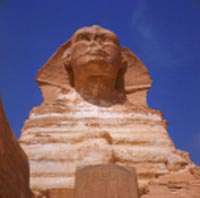Art History
Ancient ArtEgyptArchitectureThe SphinxThe Sphinx is one of the best known monuments of Ancient Egyptian Architecture. Unusual to the form of most Egyptian pyramid structures, it stands as a symbol of the strength of the Ancient Necropolis of Giza and as homage to the strength of the King. The Sphinx was originally commissioned by Kaphre (a son of
Cheops), and was constructed from bedrock found within the Valley of Giza. The age of the Sphinx has been estimated to be roughly 4,636 years old and it dates from the time of the
Fourth Dynasty. When construction began is not entirely known, the identity of the architect is not known either, though the alignment of the Sphinx with the Pyramid of Kaphre suggests a political affiliation.
Another unique feature of the Sphinx is the presence of paint residue which suggests that at one time the Sphinx was painted, in which case the head piece probably resembled the colorful
head piece attire traditionally worn by the pharaohs of the time. The most notable features of the Sphinx, such as the nose and beard, have not withstood well over time. The nose was shot off during target practice by Turkish soldiers and the Sphinx's beard has entirely been worn away by wind and sand erosion.

Addition to the usual wear and tear of time, erosion has taken a great toll upon the sphinx. Over the years, the Sphinx has been buried by sand numerous times, causing the softer stone of the monument to be worn away (hence the rippling effect of layered stone). To keep the monument within it's past and present shape, the Ancient Egyptians from theOld Kingdom into the new, and even in the time of the modern Twentieth Century, have added to the monument to maintain it structurally. The Sphinx has also had to be dug out from the desert sand numerous times throughout the centuries. The continually digging out of the Sphinx is evidenced by the Dream Stella (a stone engraved with hieroglyphs) in between the paws of the Sphinx. The Dream Stella tells the story of
Thutmosis IV, who fell asleep below the Sphinx and had a dream that the Sphinx told him to dig the monument out of the sand. In return, the Sphinx promised
Thutmosis IV, that when he cleared the Sphinx he would become king of Egypt. The Sphinx has since been cleared most recently in 1905.
The Pyramids of Giza
The pyramids of Giza are perhaps the only true rival to
the Great Sphinx, when one thinks about Ancient Egypt and its architecture. Thevalley ofGiza with its wonderful monuments is truly a marvel of architectural prowess. The three Pyramids consist of The Great Pyramid of
Khufu, The Pyramid of Kafhre and The Pyramid of Menkaura. Each Pyramid is a tomb to a different King of Egypt.
All three pyramids were built during the Third and Fourth Dynasty, and were monumental undertakings of the king and the kings sons. The Pyramid of Khufu has a base which covers roughly a nine acre area (roughly 392,040 square feet). The pyramid of Menkaura, unlike the other pyramids, had one tier of it's base covered in granite. The pyramid of Khafre, had a two tier base encased in granite.
Unfortunately like many of the great Kings of the
Old Kingdom of Egypt, the Pyramid of Menkaura, Khufu, and Kafhre were not finished in the time of the end of the Kings reign. In the case of Menkaura, the king died before its construction was completed. The monuments of Giza and the entire Giza valley stand as a marvelous reminder of the skill executed in the creation of the pyramids, and are truly fabulous to see.
The Step Pyramid Complex
Around 2630 B.C., in the 3rd Dynasty, a man named Djoser-Netcherikhe assumed the throne ofEgypt. He made his capital just south of what is now
Cairo, The Greeks called this place,
Memphis. Like all pharaohs he began making preparations for his afterlife. He assigned a scholar named Imhotep the job of building his tomb.
. . . .Imhotep's plans would incorporate many new ideas. The building material of the time was mud brick, but this would not suit a pharaoh as mighty as Djoser-Netcherikhe. Imhotep had a radical idea, he would use stone, a material never used before in large scale building projects. Originally the plan called for a mastaba tomb, a design the Egyptians had used for centuries. Imhotep had a better idea; he began stacking mastaba on top of mastaba until he realized the design of the Step Pyramid. It was a shape the ancient Egyptians recognized as the legendary
mound of creation that had risen out of the primordial ocean of chaos. It was also the shape of things to come. For almost 1000 years the pharaohs built pyramids as their eternal resting places. Abandoning them when they realized that under these giant monuments of extravagant wealth they could no longer protect their afterlives from plunder.
The Golden Mask
of
Tutankhamen
This mask is 24 pounds of solid gold, inlaid lapis lazuli, carnelian, quartz, turquoise, obsidian, and colored glass. When the boy king's tomb was found in 1922 by Howard Carter, the king rested inside three golden coffins. Two were made of wood with gold overlay; the third was 296 pounds of solid gold. He was wearing the mask shown above. Tutankhamen only lived about 18 years. He assumed the throne at around the age of 7. For most of his reign he was little more than a figurehead of a government that began reestablishing the stability of the traditional art and religion torn down by his predecessor,
Akhenaton. The amount of wealth that was showered on this boy in his short life is truly staggering. Imagine the riches that must have been bestowed on Egypt in more stable and prosperous days.
Taken from:
http://www.mankato.msus.edu/emuseum/prehistory/egypt/architecture/architect.html